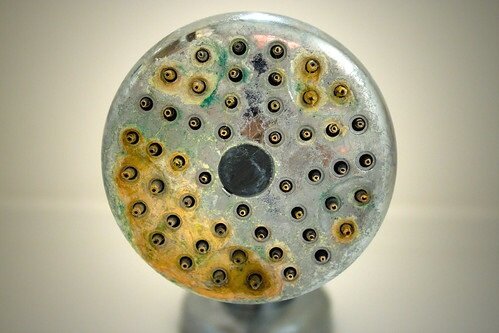The simple act of turning on your faucet or stepping into your shower should be a moment of comfort, not concern. Yet, for many homeowners, this routine moment is abruptly interrupted by a startling sight: water that is no longer crystal clear, but cloudy, murky, or even an unappealing shade of red or brown. If you have noticed this unsettling phenomenon, you are witnessing one of the most visible and urgent warning signs your home’s plumbing system can offer.
This discolored water is not just an aesthetic annoyance; it is a critical indicator that a major component of your plumbing infrastructure, most often your water heater, is struggling or failing. Your water heater is the unsung hero of your home, silently providing the hot water necessary for cooking, cleaning, and bathing. When its internal environment is compromised by years of mineral buildup or corrosion, the result manifests directly in the water you use every day. Ignoring this sign can lead to permanent appliance damage, costly leaks, and a potential health concern. Understanding the specific color of the water and where it originates is the key to accurate diagnosis and timely repair, securing the safety and longevity of your home’s essential systems.
How Can I Tell If the Water Heater is the Problem, Not the Pipes?
Before jumping to the conclusion that your water heater is the source of the trouble, it is essential to first play detective and isolate the issue. The single most crucial diagnostic tool you have is observing whether the discoloration affects both the hot and cold water, or only the hot water. This quick, easy test can immediately pinpoint the location of the problem—the appliance or the supply lines.
If the water is running brown or rusty from your water heater, the discoloration will generally appear only when you turn on the hot water tap. This is because the hot water is pulled directly from the tank, where contaminants are either accumulating or actively being produced.
If the issue is isolated to the hot water:
- The source is almost certainly the water heater tank itself.
- Contaminants like rust or sediment have built up inside the tank and are being mixed with the water as it heats and flows.
- The integrity of the appliance is compromised, requiring immediate professional attention.
However, if you check multiple faucets in your home and find that both the hot and cold water are running the same discolored hue, the source is likely elsewhere. This broader issue often points to:
- Corroded Main Pipes: Older homes with galvanized steel pipes may be releasing rust flakes into the entire home supply.
- Municipal Water Issues: Disturbances in the local water main, such as construction, flushing fire hydrants, or nearby water line breaks, can stir up sediment in the public water supply, affecting both hot and cold lines temporarily.
Performing this simple Hot vs. Cold test is the first step toward a correct diagnosis. If the problem resides only on the hot side, it is time to focus entirely on the appliance that provides your family’s comfort, your water heater.

What Causes Hot Water to Turn Red, Brown, or Yellow?
When your hot water takes on a rusty or yellow tint, the primary culprit is almost always iron oxide, or rust, which is a direct byproduct of metal corrosion. This reddish-brown color is the most alarming sign that your water heater is undergoing a serious internal breakdown.
The Anode Rod’s Sacrifice: When Corrosion Takes Over
Traditional tank-style water heaters are built primarily from steel, a material highly susceptible to rust when constantly submerged in water. To prevent this inevitable corrosion from eating through the tank itself, manufacturers install a component known as the sacrificial anode rod.
- What it is: A long rod, usually made of magnesium, aluminum, or zinc, that runs through the center of your tank.
- How it works: It is purposefully made of a more reactive metal than the steel tank. Corrosive elements and chemical reactions in the water are magnetically drawn to this rod, causing it to “sacrifice” itself by corroding away first.
- The Warning Sign: Once the anode rod is fully depleted (typically after 5 to 8 years, but often sooner in areas with hard or soft water), the corrosive elements have no choice but to attack the unprotected steel walls of the tank.
- The Result: Flakes of rust break off the tank interior and mix with the heated water, leading to the rusty, red-brown appearance in your faucet.
If the water is rusty, it means the anode rod failed long ago, and the life clock on your water heater tank has started ticking down rapidly. Rust-colored hot water is a clear sign that a leak is imminent, and the only viable long-term solution is usually a full water heater replacement.
Can Rusted Galvanized Pipes Cause Hot Water Discoloration?
While internal tank corrosion is the most common cause of hot-only rusty water, you may still be dealing with pipe corrosion if your home has older galvanized steel plumbing. It is possible for heavily corroded hot water supply lines to show discoloration more readily than the cold lines for a few reasons:
- Increased Water Temperature: Hot water tends to accelerate the chemical reaction of corrosion inside the pipes.
- Less Frequent Use: Hot water pipes can be used less frequently than cold water lines, allowing rust particles more time to settle and accumulate before being flushed out.
If you suspect your pipes are the issue, a professional can confirm the diagnosis by inspecting the supply lines near your water heater or checking the composition of your home’s existing plumbing materials. However, if the water runs clear after just a few minutes of flushing the tap, the problem is usually temporary sediment, but persistent rust means pipe replacement (re-piping) may be necessary to restore water quality permanently.
Why is My Hot Water Cloudy, Murky, or Gritty?
When the water coming from your hot tap appears cloudy, murky, or contains a distinct gritty texture, the root cause is typically not rust, but sediment buildup. This is a pervasive issue in nearly all tank-style water heaters, especially those in regions with hard water.
The Culprit: Mineral Sedimentation
Sediment is essentially a collection of dissolved solids and minerals, primarily calcium and magnesium, that naturally exist in your water supply. When water is heated to high temperatures, these minerals precipitate out of the water and settle at the bottom of the water heater tank.
- Hard Water Effects: Homes with hard water experience this issue much faster and more severely, as the concentration of calcium and magnesium is significantly higher.
- Appearance: This buildup can manifest in the water as a cloudy, hazy, or milky appearance, often containing visible white, gray, or sand-like particles that settle quickly in a glass.
- Consequences: While sediment itself is generally harmless to consume, its presence inside the water heater tank has detrimental effects on the appliance’s performance and lifespan.
The Warning Signs: Noise and Inefficiency
The physical presence of sediment at the bottom of the tank creates a layer of insulation between the heating element or gas burner and the water. This forces the unit to work harder and run longer to reach the thermostat setting, leading to several noticeable symptoms:
- Rumbling, Popping, or Hissing Noises: This is the most famous symptom. As the heating elements attempt to heat the water, they are forced to heat the layer of mineral sediment instead. Trapped water pockets within the sediment boil and bubble, causing a loud, distinct rumbling or popping sound similar to popcorn being made.
- Decreased Efficiency and Higher Bills: Because the heat transfer is blocked by the sediment layer, the water heater runs inefficiently. This directly translates to increased gas or electricity consumption and higher monthly utility bills.
- Reduced Hot Water Supply: The sediment takes up space, effectively shrinking the tank’s holding capacity. It also hinders heating, meaning you may run out of hot water much faster than before, leading to short showers.
- Premature Element Failure: For electric water heaters, the heating elements can overheat trying to burn through the sediment, leading to burnout and failure.
The solution for a sediment problem is typically a professional water heater flush, which uses high-pressure water to drain and clear the tank of the accumulated deposits.
What Does It Mean If My Water is Green, Blue, or Black?
While rust and sediment account for most discolored hot water issues, other colors require their own distinct diagnoses. These less common hues can signal specific problems within your pipes or tank environment.
Green or Blue Water: Corroding Copper
If your hot water has a faint blue or green tint, or if you see blue-green stains around your sink, tub, or shower fixtures, the issue points toward copper corrosion.
- The Cause: Your home’s plumbing is likely built with copper pipes. If the water’s pH balance is too acidic (low pH), or if the water velocity is too high, the water can aggressively dissolve small amounts of copper from the piping.
- The Water Heater Connection: While the water heater tank itself is steel, the hot water is traveling through the copper lines leading out of the tank. Hot water often accelerates this copper leaching process.
- Implications: Copper corrosion is more of a water quality issue than a water heater failure sign, but it is serious because high copper levels can be harmful to health and can damage other appliances.
Black or Dark Water: Manganese and Iron Bacteria
Seeing black water is arguably the most alarming symptom, but it usually has two main explanations:
- High Manganese Sediment: Manganese, a mineral often found in well water alongside iron, can create a black or dark-colored sediment in the water heater tank. When disturbed, this sediment is released, causing a grayish-black tint.
- Iron-Reducing Bacteria (IRB): In some private well systems, specific bacteria can thrive in the warm, oxygen-depleted environment of the water heater. These bacteria consume iron and manganese, producing a black, sludgy, or slimy byproduct that can give the water a terrible odor (often “rotten egg” or sulfurous) and a dark color.
In either case, a full water heater flush and disinfection (shock chlorination) are typically needed to eliminate the problem. However, if the tank is old and heavily compromised, replacement is necessary to fully remove the bacteria’s habitat.

What Are the Immediate Solutions and Next Steps for Discolored Water?
Identifying the color of your discolored hot water is only the first step; taking prompt action is crucial to preventing expensive property damage, conserving energy, and restoring your home’s water quality. Depending on the color and cause, the solutions will vary in scope, but they all require professional precision.
1. Water Heater Flushing and Maintenance
If the discoloration is cloudy, murky, or involves white/gray grit, the primary solution is a professional water heater flush (or tank draining). This process involves:
- Shutting Off Power: Ensuring safety by turning off the gas or electrical supply to the unit.
- Connecting a Hose: Attaching a standard hose to the drain valve at the bottom of the tank.
- Draining: Completely draining the tank to wash out the years of accumulated mineral sediment and debris.
- Refilling and Testing: Refilling the tank with fresh water and restoring power.
Regular flushing, recommended annually, is the single best preventative maintenance measure against sediment-related discoloration and efficiency loss.
2. Anode Rod Inspection and Replacement
If your water is consistently running red, brown, or rusty, and the tank is not yet leaking, you may be able to buy some time or even save a relatively new water heater by replacing the anode rod.
- Inspection: A qualified technician must remove the old rod to assess its condition. If it is nearly gone, it can be replaced with a new magnesium, aluminum, or powered anode rod.
- The Critical Window: Replacing a depleted anode rod can halt further tank corrosion. However, if the corrosion has already caused significant rust flakes to appear in the water, the tank wall integrity may already be compromised, and the fix is only temporary.
3. Water Heater Replacement: When the Tank is Compromised
For many homeowners, especially those with tanks over 10 years old that are producing rusty water, the only reliable long-term solution is complete unit replacement. Once rust flakes are visible in your water, it means the steel tank itself is rusting, and the material failure is irreversible.
- Age and Safety: A rusting tank is a ticking time bomb for a catastrophic leak that could dump 40 to 80 gallons of water into your home. Replacing an older unit prevents this disaster.
- Efficiency Upgrade: Replacing an old tank with a new high-efficiency model, such as a modern tank-style heater or a tankless unit, immediately solves the water quality issue while dramatically reducing energy consumption and utility bills.
Conclusion: Don’t Wait for the Leak
Discolored hot water is your water heater’s desperate cry for help. Whether it is a brown, rusty tint signaling irreversible tank corrosion, or a cloudy, gritty look caused by insulating sediment, this issue demands prompt professional action. Ignoring the signs, the rusty water, the popping sounds, or the sudden loss of hot water capacity, will not make the problem disappear. It will only guarantee that the next emergency call you make will be to deal with a severe flood and a completely failed appliance.
Restoring your home’s water quality and protecting your family’s comfort is simple when you partner with the right experts. At Advanced Home Services, our certified technicians specialize in diagnosing the exact cause of water discoloration, whether it requires a quick tank flush, an anode rod replacement, or a stress-free replacement of your aging unit. We provide upfront pricing and dependable, long-lasting solutions for all your home repair needs.
Do not let a small splash of brown water turn into a devastating home flood. If you have noticed any discoloration, unusual odors, or strange sounds coming from your water heater, the time to act is now.
Ready to clear up your water?
Call Advanced Home Services today to schedule your water heater diagnostic and get back to enjoying crystal-clear hot water.
Contact Advanced Home Services for your water heater repair needs!
Frequently Asked Questions About Causes Of Discolored Water
Q: Is it safe to drink or shower in rusty hot water?
A: While rust (iron oxide) is generally not an immediate health hazard in small quantities, water that is consistently rusty or has a metallic taste should not be consumed. The discoloration is a sign that your water heater’s internal lining is corroding, which means the water may contain higher levels of metals or sediments than is safe for continuous use. You should stop using the water for cooking and drinking immediately and contact a professional for diagnosis.
Q: How long can I wait after seeing rusty water before I need to replace my water heater?
A: Rusty hot water signals that the sacrificial anode rod has been completely consumed, and the steel tank walls are actively corroding. This means the tank is nearing the end of its life, and a leak is imminent. While the timeline varies based on tank size and water chemistry, you typically have anywhere from a few weeks to a few months. It is crucial to schedule a replacement inspection immediately to avoid a catastrophic leak.
Q: Can flushing my water heater fix rusty water?
A: Flushing a water heater is primarily effective for removing sediment (cloudy or murky water). If the water is truly rusty (red/brown), flushing will temporarily clear the visible flakes, but it cannot repair the underlying corrosion of the tank wall. The rust will return as long as the unprotected steel is exposed to water. Flushing is a maintenance action, not a corrective action for internal tank failure.
Q: Does my water softener affect the corrosion in my water heater?
A: Yes, it can. While water softeners remove hard minerals like calcium, the resulting soft water can sometimes be more corrosive (known as “hungry water”). Softened water can accelerate the consumption of the anode rod, meaning the rod needs to be inspected and replaced more frequently than recommended in homes without a softener to ensure the steel tank remains protected.
Q: What is the average lifespan of a water heater, and when should I consider replacement based on age?
A: The typical lifespan of a conventional tank water heater is 8 to 12 years. If your unit is approaching or exceeding the 10-year mark and is producing any form of discoloration, rumbling noises, or frequent leaks, it is highly economical to replace the unit proactively rather than paying for temporary repairs on an old tank that is due to fail.

